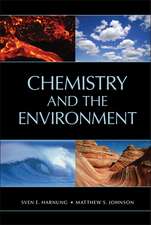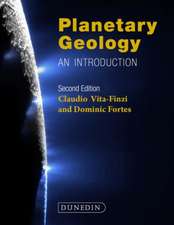Heterogeneous Processes of Geochemical Migration
Autor V. S. Golubeven Limba Engleză Paperback – 30 mar 2012
Preț: 386.81 lei
Nou
Puncte Express: 580
Preț estimativ în valută:
74.01€ • 77.28$ • 61.26£
74.01€ • 77.28$ • 61.26£
Carte tipărită la comandă
Livrare economică 05-19 aprilie
Preluare comenzi: 021 569.72.76
Specificații
ISBN-13: 9781468415896
ISBN-10: 1468415891
Pagini: 164
Ilustrații: VIII, 150 p.
Dimensiuni: 210 x 279 x 9 mm
Greutate: 0.39 kg
Ediția:1971
Editura: Springer Us
Colecția Springer
Locul publicării:New York, NY, United States
ISBN-10: 1468415891
Pagini: 164
Ilustrații: VIII, 150 p.
Dimensiuni: 210 x 279 x 9 mm
Greutate: 0.39 kg
Ediția:1971
Editura: Springer Us
Colecția Springer
Locul publicării:New York, NY, United States
Public țintă
ResearchCuprins
1. Formulating the Problem of the Geochemical Migration of Included Substances, and Methods of Solving It.- § 1. Formulating the problem of geochemical migration of included substances.- § 2. Equations of material balance and kinetics of the processes of interaction between a substance and host rocks.- § 3. Hydrodynamic equations.- § 4. Simplification and methods of solving the problem.- § 5. The geochemical migration of mixtures.- Literature cited.- 2. Diffusion in Rocks.- § 6. Laws of diffusion.- § 7. Solutions of diffusion equacions for steady-state current.- § 8. Solutions of the linear equation of nonstationary diffusion for an unbounded body.- § 9. Solutions of the linear equation of nonstationary diffusion for a semibounded body.- § 10. Solutions of the diffusion equation for a finite body.- § 11. Factors affecting the coefficient of diffusion.- § 12. Aspects of diffusion in rocks.- § 13. Methods of determining coefficients of diffusion in rocks.- § 14. Description of the diffusion of salt in rocks.- § 15. Experimental data on the diffusion of salt in rocks.- § 16. The effect of moisture content on the diffusion of salt in rocks.- § 17. Experimental data on the diffusion of gases in rocks.- Literature cited.- 3. Adsorption and Ion Exchange in the Interaction of Solutions and Gases with Rocks.- § 18. The concept of adsorption.- § 19. Adsorption isotherms of gases and vapors on a homogeneous surface.- § 20. Adsorption of gases and vapors by porous adsorbents.- § 21. Adsorption of solutions on the surface of solids.- § 22. Ion exchange.- § 23. The concept of chemisorption.- § 24. Ion-exchange equilibrium in soils.- § 25. Investigation of adsorption and ion exchange in rocks.- § 26. Adsorption of gases on rocks.- Literature cited.- 4. TheKinetics of Adsorption, Ion Exchange, and Chemical Reactions of Solutions and Gases with Rocks.- § 27. The basic aspects of formal kinetics.- § 28. Heterogeneous processes.- § 29. Kinetic and diffusion regions of heterogeneous chemical reaction.- § 30. The kinetics of adsorption and ion exchange.- § 31. Equations of internal-diffusion kinetics of adsorption and ion exchange.- § 32. The effect of temperature on reaction rate.- § 33. Methods of studying the kinetics of heterogeneous processes.- § 34. Experimental data on the kinetics of heterogeneous processes in rocks.- Literature cited.- 5. The Kinetics of Adsorption, Ion Exchange, and Chemical Reaction in a Current.- § 35. The kinetics of adsorption and ion exchange in the external-diffusion region.- § 36. The kinetics of adsorption and ion exchange in the internal-diffusion region.- § 37. The kinetics of adsorption and ion exchange with simultaneous consideration of intergranular and intragranular diffusion.- § 38. The kinetics of adsorption and ion exchange due to flow.- § 39. Determination of the diffusion mechanism controlling the rate of adsorption and ion exchange.- § 40. The kinetics of heterogeneous chemical reactions in a current.- § 41. Study of the kinetics of ion exchange in rocks from a current.- Literature cited.- 6. Geochemical Migration Due to Filtration and Diffusion.- § 42. Diffusion in a heterogeneous medium with consideration of adsorption and ion exchange.- § 43. Diffusion in a heterogeneous medium, considering chemical reactions.- § 44. Filtration in a heterogeneous medium in the absence of interaction between substance and medium.- § 45. Filtration of a one-component solution in a porous medium, considering adsorption and ion exchanges.- § 46. Geochemical migration due tofiltration in a weakly adsorbent medium.- § 47. Filtration in a heterogeneous medium with consideration of chemical reaction.- § 48. Filtration of a mixture of substances.- § 49. A dynamic method of determining the kinetic coefficients of adsorption and ion exchange.- § 50. Experimental results on filtration of solutions not interacting with the rocks.- § 51. A study of diffusion and filtration of adsorbable solutions and gases in rocks.- § 52. The so-called “filtration effect”.- Literature cited.- 7. The Theory of Formation of Hydrothermal Deposits and Geochemical Aureoles at Deposits of Ores and Gas.- § 53. The formation of hydrothermal deposits and primary aureoles by interaction between solution and country rock.- § 54. The formation of deposits by reaction between components of hydrothermal solutions.- § 55. The theory of forming secondary geochemical aureoles of ore and gas deposits.- § 56. The question of oil formation.- Literature cited.










